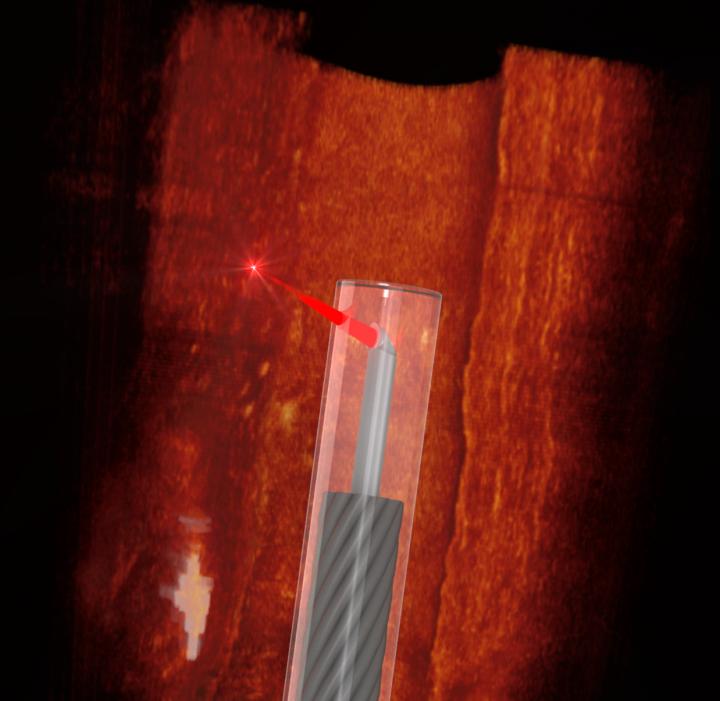World's smallest imaging device has heart disease in focus

Ultrathin 3D printed endoscope imaging an artery. Image by Simon Thiele and Jiawen Li
The camera-like imaging device can be inserted into blood vessels to provide high quality 3D images to help scientists better understand the causes of heart attack and heart disease progression, and could lead to improved treatment and prevention.
In a study published in the journal Light: Science & Applications, a multidisciplinary team of researchers and clinicians was able to 3D print a tiny lens on to the end of an optical fibre, the thickness of a human hair.
The imaging device is so small that researchers were able to scan inside the blood vessels of mice.
Dr Jiawen Li, co-author and Heart Foundation Postdoctoral Fellow at the Institute for Photonics and Advanced Sensing, University of Adelaide, says in Australia cardiovascular disease kills one person every 19 minutes.
“A major factor in heart disease is the plaques, made up of fats, cholesterol and other substances that build up in the vessel walls,” Dr Li said.
“Preclinical and clinical diagnostics increasingly rely on visualising the structure of the blood vessels to better understand the disease.
“Miniaturised endoscopes, which act like tiny cameras, allow doctors to see how these plaques form and explore new ways to treat them,” she said.
Dr Simon Thiele, Group Leader, Optical Design and Simulation at the University of Stuttgart, was responsible for fabricating the tiny lens.
“Until now, we couldn't make high quality endoscopes this small,” Dr Thiele said.
“Using 3D micro-printing, we are able to print complicated lenses that are too small to see with the naked eye.
“The entire endoscope, with a protective plastic casing, is less than half a millimetre across,” he said.
Dr Li explains: “It's exciting to work on a project where we take these innovations and build them into something so useful.
“It's amazing what we can do when we put engineers and medical clinicians together,” said Dr Li.
###
The research collaboration also included researchers from The South Australian Health and Medical Research Institute, The Royal Adelaide Hospital and Monash University.
Media Contact
All latest news from the category: Medical Engineering
The development of medical equipment, products and technical procedures is characterized by high research and development costs in a variety of fields related to the study of human medicine.
innovations-report provides informative and stimulating reports and articles on topics ranging from imaging processes, cell and tissue techniques, optical techniques, implants, orthopedic aids, clinical and medical office equipment, dialysis systems and x-ray/radiation monitoring devices to endoscopy, ultrasound, surgical techniques, and dental materials.
Newest articles

Pinpointing hydrogen isotopes in titanium hydride nanofilms
Although it is the smallest and lightest atom, hydrogen can have a big impact by infiltrating other materials and affecting their properties, such as superconductivity and metal-insulator-transitions. Now, researchers from…

A new way of entangling light and sound
For a wide variety of emerging quantum technologies, such as secure quantum communications and quantum computing, quantum entanglement is a prerequisite. Scientists at the Max-Planck-Institute for the Science of Light…

Telescope for NASA’s Roman Mission complete, delivered to Goddard
NASA’s Nancy Grace Roman Space Telescope is one giant step closer to unlocking the mysteries of the universe. The mission has now received its final major delivery: the Optical Telescope…



